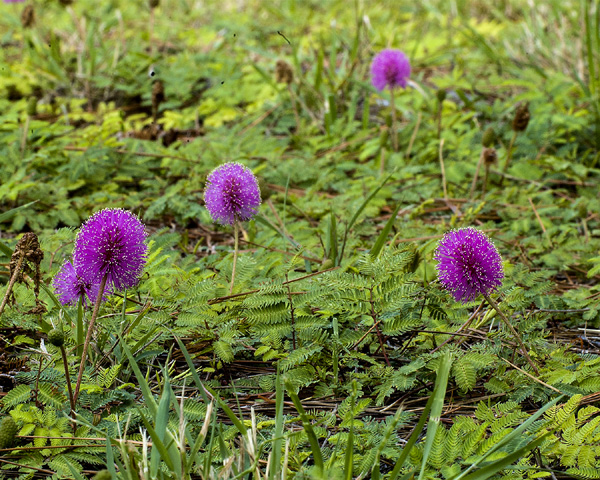Add Native Plants to Your Landscape
by Donna Bollenbach
A few
years ago my parents decided that they could no longer keep up with the
maintenance of their home. They moved in with my sister, and asked my husband
and I if we would like to live in their house. As we were between homes, we
accepted. The move from a country home on a two wooded acres to a suburban home
on a 1/3-acre lot with a tropical landscape was quite a change for us. We
missed our native trees and shrubs and all the wildlife they attracted. The
tropical vegetation was pretty, but had very little attraction for the
wildlife.
We joined the Florida Native Plant Society
Shortly
after moving, we joined the Suncoast Native Plant Society. We learned that the
native plants we took for granted in our rural home attracted more wildlife
because they preferred natives for food and shelter. In our rural landscape we
had very little grass, but lots of oaks, longleaf pines, beautyberry, firebush,
pokeweed, dewberry, holly, sweetbay, Carolina willow, elderberry and other
native plants. The wildlife in our yard included nesting owls and hawks, woodpeckers,
a variety of song birds, hummingbirds, snakes, frogs, toads, gopher tortoise,
an occasional deer or bobcat, and an abundance of bees and butterflies. While
we knew we would not be able to attract all these animals to our suburban home,
we did want to bring in the birds and butterflies, which seemed to be less
attracted to the non-native plants.
As a
member of the native plant society for nearly three years now, I also
discovered there are two approaches to planting natives: Some people take the
all or none approach: They rip up their entire yard, nix the lawn, and replant
everything with natives. Unless you can afford to hire someone to do most of
the work, the all or none approach is not practical. Furthermore, many people
are not willing to give up their bougainvillea, bird-of-paradise and
bottle-brush. We had the added consideration that my dad, a veteran gardener,
was proud of this lawn and tropical landscape and his feelings would be hurt if
we ripped it all up in one day.
We decided to go slow and integrate native plants into the landscape
The
second, and more practical approach, is to integrate native plants into your
current landscape. This is the method we adopted, and it is still a work in
progress. Our first project was a previously landscaped area of front yard near
a loquat tree. While not native, the loquat tree provides edible fruit for us
and the wildlife, so we decided to keep it. But underneath it was a thick
blanket of snake plant and philodendrons, which seemed to have little value for
wildlife, except perhaps for Cuban (non-native) lizards to hide. We pulled up all the plants in the bed,
added a little topsoil, and went shopping for native plants.
 |
| Wild coffee (Psychotria nervosa) under the loquat tree (Eriobotrya japonica). |
Unfortunately,
Hillsborough County does not have a native plant nursery, and while the big box
stores have a “Florida Friendly” section, very few of the plants are true
natives. We purchased our first natives from a native plant nursery in Sarasota
County. Since then we have purchased
most of our plants at the SNPS semi-annual native plant sales, and we’ve picked
up a few at the native plant auction following our chapter’s meetings.
We
wanted plants that were suitable for the location that we were planting them
without any added fertilizer or pesticides. One, pesticides are harmful to the
birds, butterflies and bees that we were trying to attract. Two, when it rains
the chemicals in pesticides and fertilizers wash into the ground and end up in
our lakes, rivers and eventually, our drinking water, so they are not good for
people either.
Our soil
was average, neither moist nor dry, and drained well. There were areas of shade, part sun and full sun in the bed. In
the shaded areas we planted wild coffee. In the areas that received part sun we
put in Simpson’s stopper. In the sunny areas we planted firebush, cassia, blue
porterweed, blue mist, and a native mimosa. We planted red, white and pink
salvia throughout.
 |
| Firebush (Hamelia patens) |
 |
| Scarlet sage (Salvia coccinea) |
We
watered the plants daily for a few weeks to establish them. (If planted in the
right place, native plants need little irrigation, but like any potted plant,
they do need water when they are first put in the ground or in the case of a
drought.) Our plants grew like crazy, especially the blue porterweed. It turns
out the porterweed we purchased was not the native species which stays low, but
a non-native that grows tall and unwieldy. It did attract lots of butterflies
though, and hummingbirds, as did the firebush and the salvia. We allowed the
blue porterweed to stay until it started toppling over on the firebush. Then I
removed it and replanted it next to a fence line where it is just as happy. A
native garden, like any garden, is trial and error.
 |
| Monarch on blue porterweed (Stachytarpheta jamaicensis). |
The whole garden is filled with the color of wings and the buzzing of bees.
 |
| Scarlet wasp moth on blue mistflower (Conoclinium coelestinum). |
The
integrated approach to planting natives works for us. It allows us the time to
evaluate and enjoy each new area. And, our native plants did bring in the birds
and butterflies. Sometimes the whole garden seems to be filled with the color
of wings and the buzzing of bees.
 |
| Ground cover, Powderpuff (Mimosa strigillosa). |
 |
| Our Florida (Mostly) Native Landscape |
###
Posted by Ginny Stibolt.




Comments